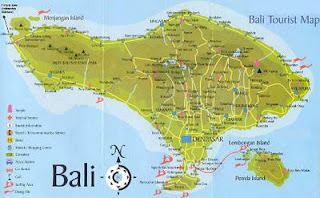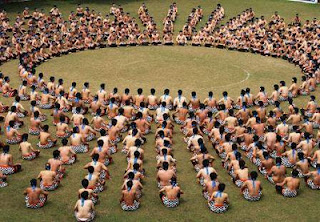 |
| Bali Map |
The richness of Bali’s arts and crafts has its origin in the fertility of the land. The purest forms are the depictions of Dewi Sri, the rice goddess, intricately made from dried and folded strips of palm leaf to ensure that the fertility of the rice fields continues. Until the tourist invasion, the acts of painting or carving were purely to decorate temples and shrines and to enrich ceremonies. Today, with galleries and craft shops everywhere, paintings are stacked up on their floors and you trip over stone- or woodcarvings. Much of it is churned out quickly, but you will still find a great deal of beautiful work Balinese dance, music and wayang kulit (a leather puppet used in shadow puppet plays) performances are one of the reasons that Bali is much more than just a beach destination. The artistry on display here will stay with you long after you’ve moved on from the island. On Lombok you can find excellent crafts, including pottery in villages such as Banyumulek. There are many shops and galleries with good items in Mataram and Senggigi
Dance
 |
| legong dance |
For a perspective on the state of dance in Bali today from one of its top dancers, see the boxed text. Many tourist shows in South Bali hotels offer a smorgasbord of dances –a little Kecak, a taste of Legong and some Barong to round it off. Some of these performances can be pretty abbreviated with just a few musicians and a couple of dancers. Balinese love a blend of seriousness and slapstick, and this shows in their dances. Some have a decidedly comic element, with clowns who convey the story and also act as a counterpoint to the staid, noble characters. Most dancers are not professionals. Dance is learned by performing, and carefully following the movements of an expert. It tends to be precise, jerky, shifting and jumpy, remarkably like Balinese music, with its abrupt changes of tempo and dramatic contrasts between silence and crashing noise. There’s little of the soaring leaps or the smooth flowing movements of Western dance. Every movement of wrist, hand and fingers is charged with meaning; and facial expressions are carefully choreographed to convey the character of the dance. Watch the local children cheer the good characters and cringe back from the stage when the demons appear.
Kecak
 |
| kecak dance |
The Barong is a strange but good, mischievous and fun-loving shaggy dog-lion. The widowwitch Rangda is bad through and through. The story begins with Barong Keket, the most holy of the Barong, enjoying the acclaim of its supporters – a group of men with kris (traditional daggers). Then Rangda appears, her long tongue lolling, terrible fangs protruding from her mouth, human entrails draped around her neck, and pendulous parodybreasts. (In fully authentic versions – which are rarely seen by visitors – the Rangda is covered with real entrails from freshly slaughtered animals.) The Barong and Rangda duel, and the supporters draw their kris and rush in. The Rangda throws them into a trance that makes them stab themselves. But the Barong dramatically casts a spell that stops the kris from harming them. They rush back and forth, waving their kris, rolling on the ground, desperately trying to stab themselves. It’s all a conspiracy to terrify tourists in the front row! Finally, the terrible Rangda retires and good has triumphed again. The entranced Barong supporters, however, still need to be sprinkled with holy water. Playing around with all that powerful magic, good and bad, is not to be taken lightly. A pesmangku (priest for temple rituals) must end the dancers’ trance and a chicken must be sacrificed after the dance to propitiate the evil spirits. Legong This most graceful of Balinese dances is performed by young girls. It is important in Balinese culture that in old age a classic dancer will be remembered as a ‘great Legong’. Peliatan’s famous dance troupe, often seen in Ubud, is particularly noted for its Legong Keraton (Legong of the Palace). The very stylised and symbolic story involves two Legong dancing in mirror image. They are dressed in gold brocade, their faces elaborately made up, their eyebrows plucked and repainted, and their hair decorated with frangipani. The dance relates how a king takes a maiden, Rangkesari, captive. When her brother comes to release her, Rangkesari begs the king to free her rather than go to war. The king refuses and on his way to the battle meets a bird with tiny golden wings bringing ill omens. He ignores the bird and continues on, meets Rangkesari’s brother and is killed.
Sanghyang These dances were developed to drive out evil spirits from a village – Sanghyang is a divine spirit who temporarily inhabits an entranced dancer. The Sanghyang Dedari is performed by two young girls who dance a dream-like version of the Legong in perfect symmetry while their eyes are firmly shut. Male and female choirs provide a background chant until the dancers slump to the ground. A pesmangku blesses them with holy water and brings them out of the trance. The modern Kecak dance developed from the Sanghyang. In the Sanghyang Jaran, a boy in a trance dances around and through a fire of coconut husks, riding a coconut palm ‘hobby horse’. Variations of this are called Kecak Fire Dance (or Fire and Trance Dance for tourists) and are performed in Ubud almost daily. Other Dances The warrior dance, the Baris, is a male equivalent of the Legong – grace and femininity give way to energetic and warlike spirit. The Baris dancer must convey the thoughts and emotions of a warrior first preparing for action, and then meeting the enemy, showing his changing moods through facial expression and movement – chivalry, pride, anger, prowess and, finally, regret. It is one of the most complex of dances requiring great energy and skill. The Ramayana ballet tells the familiar tale of Rama and Sita but with a gamelan gong accompaniment. It provides plenty of opportunity for improvisation and comic additions.
The giant puppet dances known as Barong Landung take place annually on the island of Serangan and a few other places in southern Bali. The legend relates how the demon Jero Gede Macaling popped over from Nusa Penida, disguised as a standing Barong, to cause havoc in Bali. A huge Barong puppet was made to scare him away. The dance, often highly comical, features two gigantic puppet figures – a horrific male image of black Jero Gede and his female sidekick, white Jero Luh. In the Topeng, which means ‘Pressed Against the Face’, as with a mask, the dancers imitate the character represented by the mask. The Topeng Tua is a classic solo dance where the mask is that of an old man. In other dances there may be a small troupe who perform various characters. A full collection of Topeng masks may number 30 or 40. Mask dances require great expertise because the dancer cannot convey thoughts and meanings through facial expressions – the dance has to tell all. Dance in Bali is not a static art form. The Oleg Tambulilingan was developed in the 1950s, originally as a solo female dance. Later, a male part was added and the dance now mimics the flirtations of two tambulilingan (bumblebees). You may often see the Pendet being danced by women bringing offerings to a temple. One of the most popular comic dances is the Cupak, which tells of a greedy coward (Cupak) and his brave but hard-done-by younger brother, and their adventures while rescuing a beautiful princess. Drama Gong is based on the same romantic themes as a Balinese soap opera – long and full of high drama.
Sumber:
WISATA DUNIA
The giant puppet dances known as Barong Landung take place annually on the island of Serangan and a few other places in southern Bali. The legend relates how the demon Jero Gede Macaling popped over from Nusa Penida, disguised as a standing Barong, to cause havoc in Bali. A huge Barong puppet was made to scare him away. The dance, often highly comical, features two gigantic puppet figures – a horrific male image of black Jero Gede and his female sidekick, white Jero Luh. In the Topeng, which means ‘Pressed Against the Face’, as with a mask, the dancers imitate the character represented by the mask. The Topeng Tua is a classic solo dance where the mask is that of an old man. In other dances there may be a small troupe who perform various characters. A full collection of Topeng masks may number 30 or 40. Mask dances require great expertise because the dancer cannot convey thoughts and meanings through facial expressions – the dance has to tell all. Dance in Bali is not a static art form. The Oleg Tambulilingan was developed in the 1950s, originally as a solo female dance. Later, a male part was added and the dance now mimics the flirtations of two tambulilingan (bumblebees). You may often see the Pendet being danced by women bringing offerings to a temple. One of the most popular comic dances is the Cupak, which tells of a greedy coward (Cupak) and his brave but hard-done-by younger brother, and their adventures while rescuing a beautiful princess. Drama Gong is based on the same romantic themes as a Balinese soap opera – long and full of high drama.
Sumber:
WISATA DUNIA
